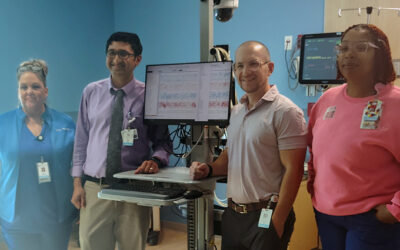“Natural” childbirth is defined differently by different people, but the goal of all childbirth is the same: healthy mom, healthy baby and a good experience for both.
Katherine Greene, CNM, and Mary Jazayeri, WHNP, CNM, certified nurse midwives at Our Lady of Lourdes Women’s & Children’s Hospital, explain the nuances of natural childbirth and what expecting moms should consider.
Another, more descriptive phrase the certified nurse midwives like to use is physiologic birth, simply allowing the birthing mom’s body to do the things it was made to do with minimal intervention to reduce potential complications. It’s a low-intervention approach to care during labor and delivery.
Mom Defines Her Birth Experience
Greene’s and Jazayeri’s approach allows the mom to decide what natural childbirth means to her, if that’s the way she hopes to deliver. For some moms “natural” means a vaginal delivery, for others it means a completely unmedicated birth, and still others may be open to some pain medication, such as through an IV rather than an epidural.
“For me, a physiologic birth would certainly involve a vaginal birth and trying to do as little intervention as possible, letting the process occur naturally,” Jazayeri says.
Benefits of Natural Childbirth
Some reasons expecting moms may want to consider a more physiologic approach to childbirth include:
- A desire for a more personalized birth experience, keeping mom and baby at the center of the process
- Awareness of the risks and side effects of medical interventions, including epidurals, episiotomies and Cesarean sections, and may prefer to avoid them if possible
- Feeling empowered and having more control of their experience
Choosing a natural childbirth attended by a certified nurse midwife in a hospital setting can give a mom the best of both worlds, having the support of obstetricians and a full medical team close at hand should complications arise.
Preparing for Labor & Delivery
Across our health system, including at Our Lady of Lourdes Women’s & Children’s Hospital, we offer childbirth classes to help expecting moms and their partners or other support people understand their delivery options.
Some other ways to prepare for childbirth include prenatal yoga, stretches, relaxation exercises are all good things to do when preparing for birth. Being in good physical condition will make labor and delivery more likely to go well no matter what birth options you choose.
An important part of preparing for labor and delivery is conversations with your healthcare provider before you come to the hospital as part of your prenatal care.
“We want moms to know their options, and we invite them to really think through what they want,” Greens says. “We try to create that quiet, safe environment for them to have a good birthing experience.”
What to Expect in the Delivery Room
Our birthing hospitals offer several aids that can help during labor including birthing balls, peanut balls, birthing bars and even sheets that can be used for tug-of-war. All are designed to help keep mom changing positions frequently during labor.
“The key is mobility — being able to get up and move,” Greene says. “In labor, movement plus gravity often equals progress.”
Jazayeri explains how the delivering mom takes the lead for positions that make her feel most comfortable.
“Squatting, pushing and delivering in positions where they feel more control are all fine,” she says. “I leave it up to the mom often, making suggestions but taking her cues. I listen to what she tells me and what makes her most comfortable.”
How Can Dads Support Natural Childbirth?
The support role is very important for birth, and not in a passive way, Greene says. “I do try to encourage them to come to prenatal visits, and also help them know how important their role is during labor and birth.”
During labor moms may not know what they need or how to articulate it. A support person, whether baby’s dad, her mom, sister or a doula or any combination, can help. “Their role is to be present with the mom and remind them of the things they can do to work through contractions, work through the discomfort to feel relaxed, comfortable and safe.”
Jazayeri says the number one way to support mom is to be there, even when labor is tough. “Some moms, as they start active labor, they may not want you touching them,” she says. “Sometimes significant others will be distraught and don’t know what to do. Being there and being supportive is all there is to do.”
VBAC
Moms who had a C-section with a previous delivery can still attempt a vaginal birth after cesarean (VBAC). At the hospital it’s called a trial of labor after C-section (TOLAC), and most of those moms are still candidates for a natural or physiologic birth.
“There are a couple things to consider to clear a mom for a TOLAC,” Jazayeri says. The type of uterine incision and why she had a C-section in the first place matters.
Additional Resource
Whether you have your birth plan determined or need help understanding your delivery options, we’re here for you through all maternity. Your pregnancy journey is unique, and we’re honored to support you along the way. We’ve curated The Ultimate Pregnancy Resource Guide to help you prepare for the big day — the birth of your baby! Download it here.
If you are pregnant or planning to become pregnant, talk to your healthcare provider about your hopes for labor and delivery. They can help you to develop a plan for managing your health through all maternity.




